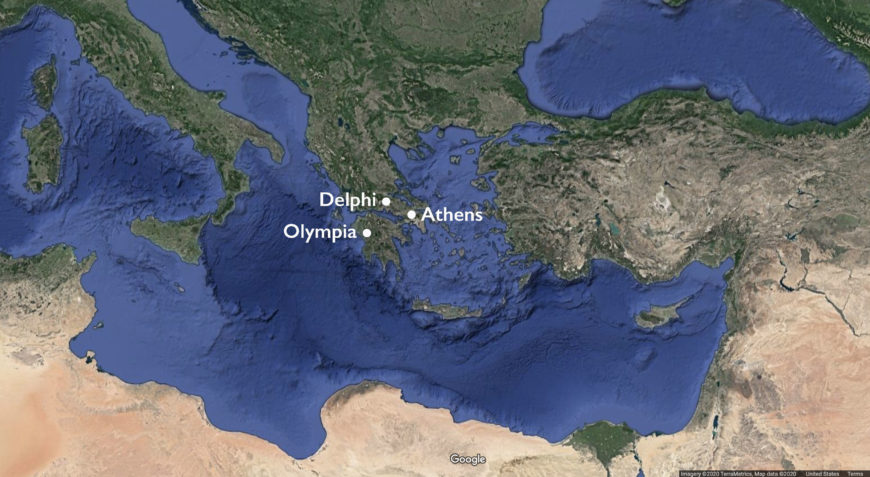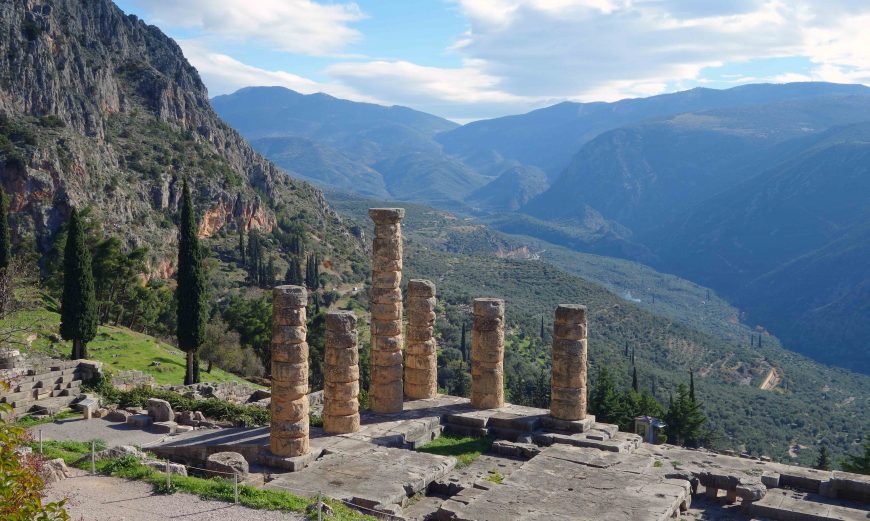
Temple of Apollo (with reconstructed columns), Sanctuary of Apollo, Delphi, Greece (photo: Steven Zucker, CC BY-NC-SA 2.0)
For the ancient Greeks, religion was inextricably tied to everyday life. Gods and many other supernatural beings could manifest anywhere, at any time, and often in unexpected forms. Yet even within such a boundless concept of religion, there were locations deemed especially numinous (the sense of divine presence) and appealing to the gods. These were the places where sanctuaries would be established, such as the sanctuary of Apollo at Delphi on the slopes of Mount Parnassos, and where more structured communications with the divine would be sought through ritual. Technically, a boundary-wall delineating the sacred area and an altar on which blood sacrifices could be made were all that was necessary to establish a sanctuary. However, in line with the piously agonistic spirit of the Greeks, sanctuaries quickly became monumental, housing colossal cult images, temples, treasuries, and copious cult accoutrements.
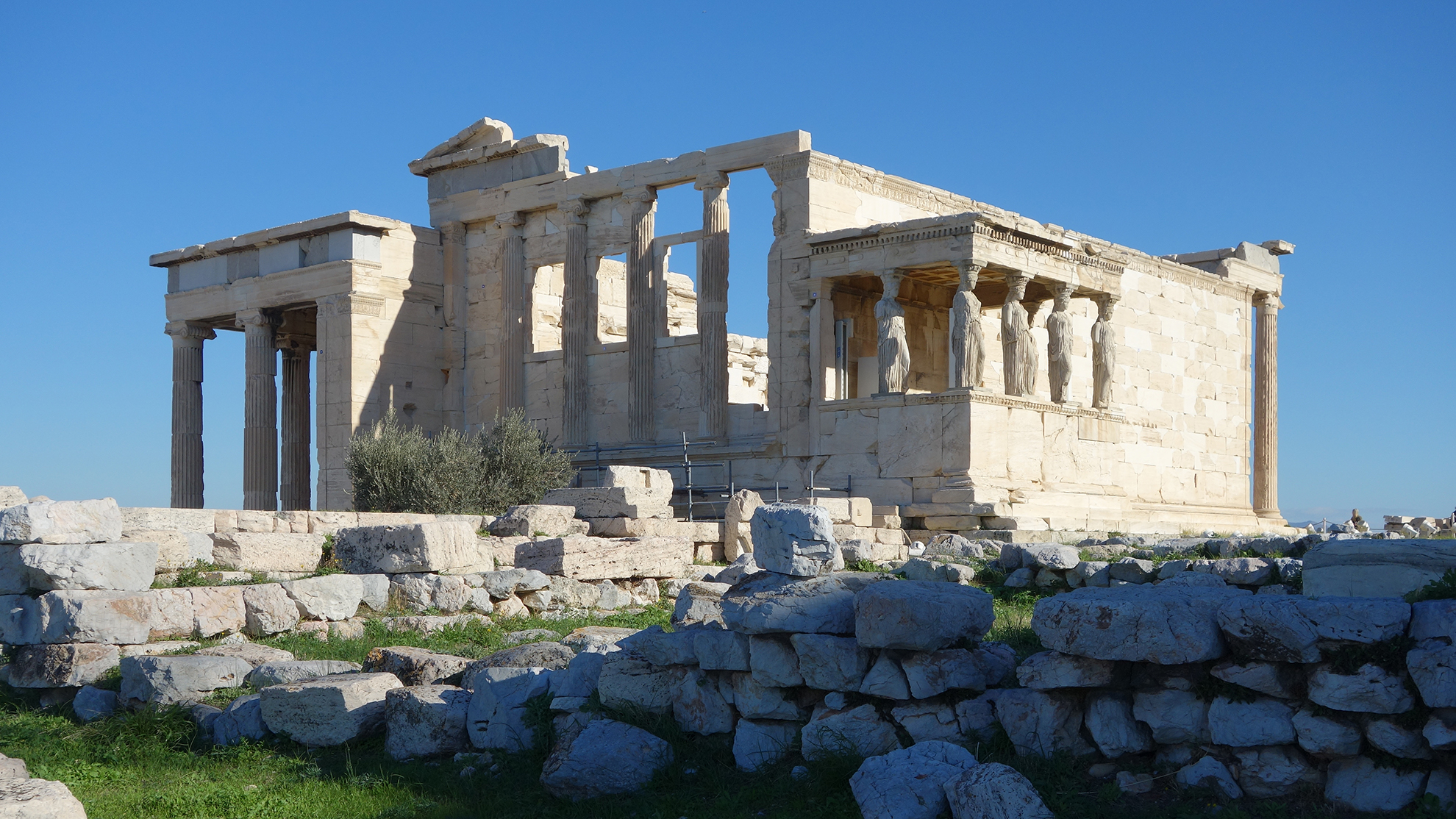
The Erechtheion, 421–405 B.C.E., Acropolis, Athens (photo: Steven Zucker, CC BY-NC-SA 2.0)
Greek sanctuaries were perennially lively venues, each with their idiosyncratic myths and rites. The Athenian Akropolis (also spelled Acropolis), whose slope and plateau were home to many sanctuaries, was where Poseidon and Athena had competed for the patronship of Athens. The mark left by Poseidon’s trident and the olive tree that sprung from the ground on Athena’s command (at the site of the Erechtheion) were two of the most marvelous sights the city boasted.
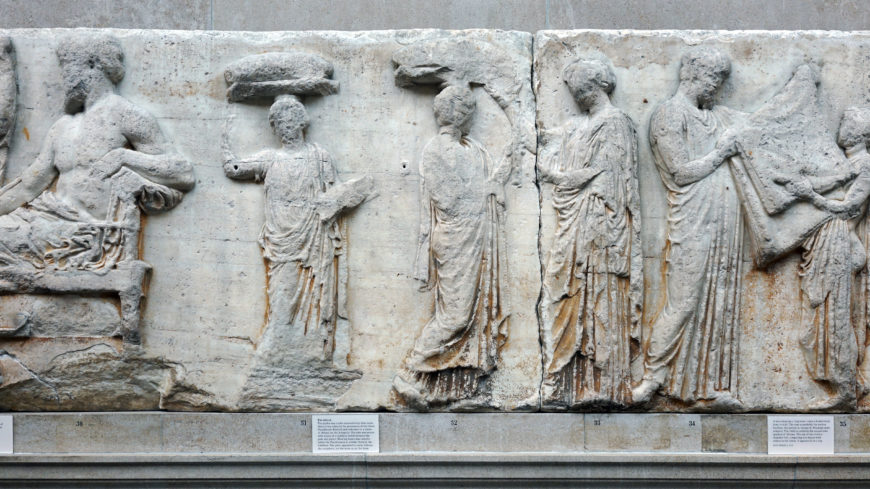
Phidias(?), “Peplos Scene,” on the Parthenon Frieze, c. 438–32 B.C.E., pentelic marble, Classical Period (British Museum; photo: Steven Zucker, CC BY-NC-SA 2.0)
Every four years, during a festival called the Greater Panathenaia, Athenians dedicated to their city goddess a monumental garment (peplos) decorated with mythical images celebrating Athena’s glories. This is only one of the instances exemplifying the transactional framework of Greek religion, for it was through performing sacrifices and dedicating votives that the Greeks believed they could achieve an audience with their gods.
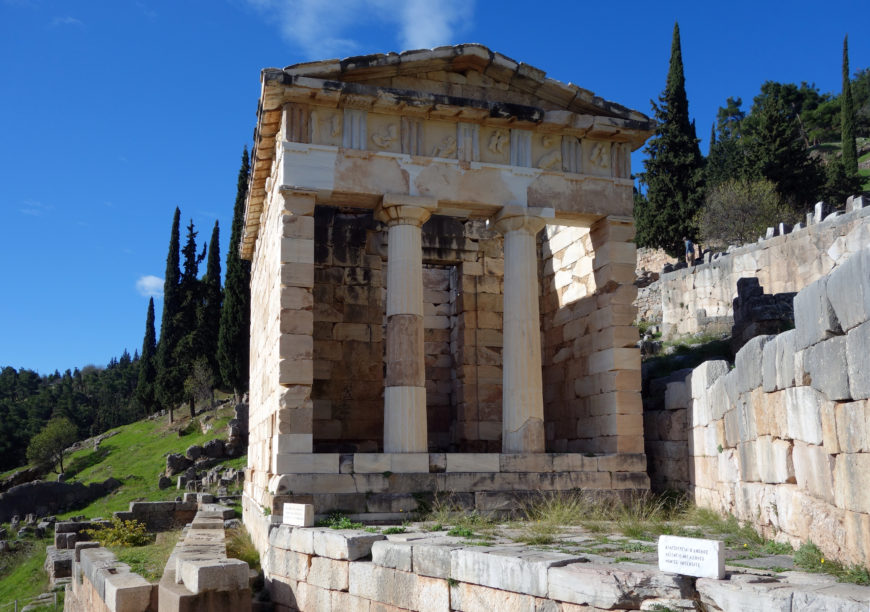
The Athenian Treasury (reconstruction) at the Sanctuary of Apollo, Delphi, Greece house votive offerings offered by Athenian citizens to the sanctuary (photo: Steven Zucker, CC BY-NC-SA 2.0)
While certain religious festivals like the Panathenaia occurred at specific intervals and on specific dates, votaries (be they individuals, tribes, or city-states) were free to dedicate gifts to the sanctuaries practically any time of the year to commemorate events, ask for favors, and thank the gods for favors fulfilled. This meant a consistent influx of artworks in various media and of varying qualities.
Some of the more famous works recorded in inscriptions and other written sources have not reached our times not only due to weathering but also because sanctuaries were ripe for looting, as they often acted as treasuries for the city-states by which they were governed. Nevertheless, the remains which we can access still reveal interactions of various kinds. We find examples of different visual media in conversation, such a ceramics that depicted stone cult statues at sanctuaries. Some materials reveal interactions between specific city-states. Literary and visual evidence across generations also help us to understand the varied roles of Greek sanctuaries and the art that once filled them. Three sanctuaries, one Athenian and two Panhellenic, illustrate these types of interactions and provide a glimpse into life at ancient Greek sanctuaries.
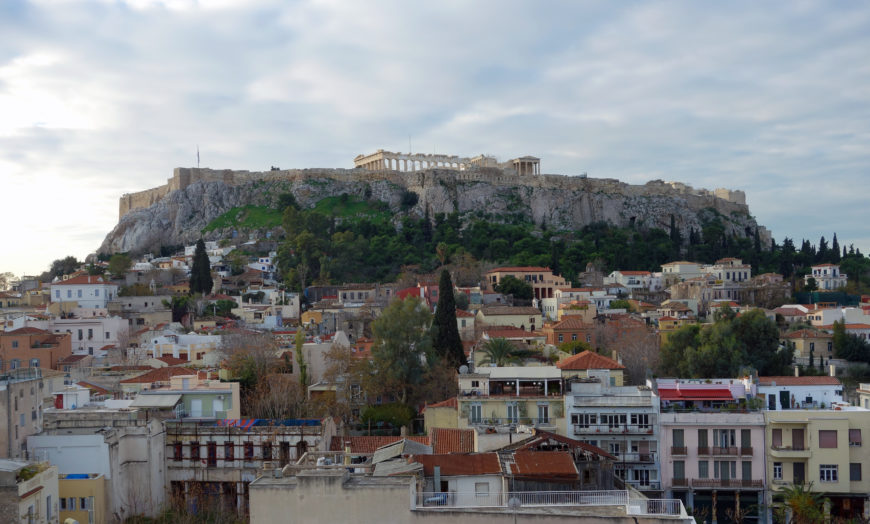
The Acropolis of Athens (photo: Steven Zucker, CC BY-NC-SA 2.0)
Sanctuaries to Athena on the Athenian Akropolis
Commanding the ancient city of Athens from all viewpoints, the Akropolis is not the city’s highest hill but certainly the most significant and symbolically charged. The cult of Athena prospered here in the Archaic Period (600–480 B.C.E.), and well into the Hellenistic Period (323–31 B.C.E.). The crest of the Akropolis, where numerous cult structures, treasuries, and dedications to Athena were localized, saw nearly ceaseless growth in tandem with Athens’ military, financial, and (later) symbolic prominence. Nearly all Greek deities had multiple aspects to their identities, and on the Akropolis several of Athena’s aspects were venerated with votive statues.
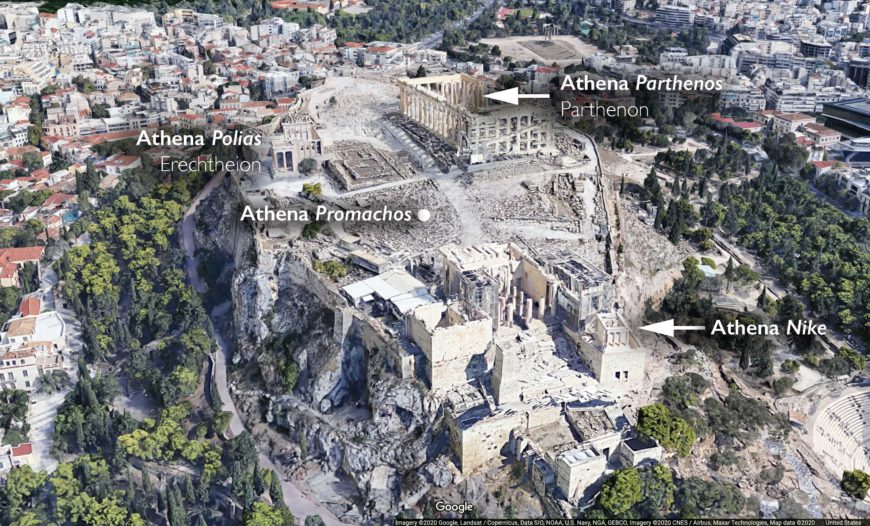
Map showing the placement of the two colossi (no longer surviving) of the Athena Promachos and the Athena Parthenos. The Erechtheion housed the Athena Polias and in the Temple of Athena Nike was another cult image of Athena (map Google)
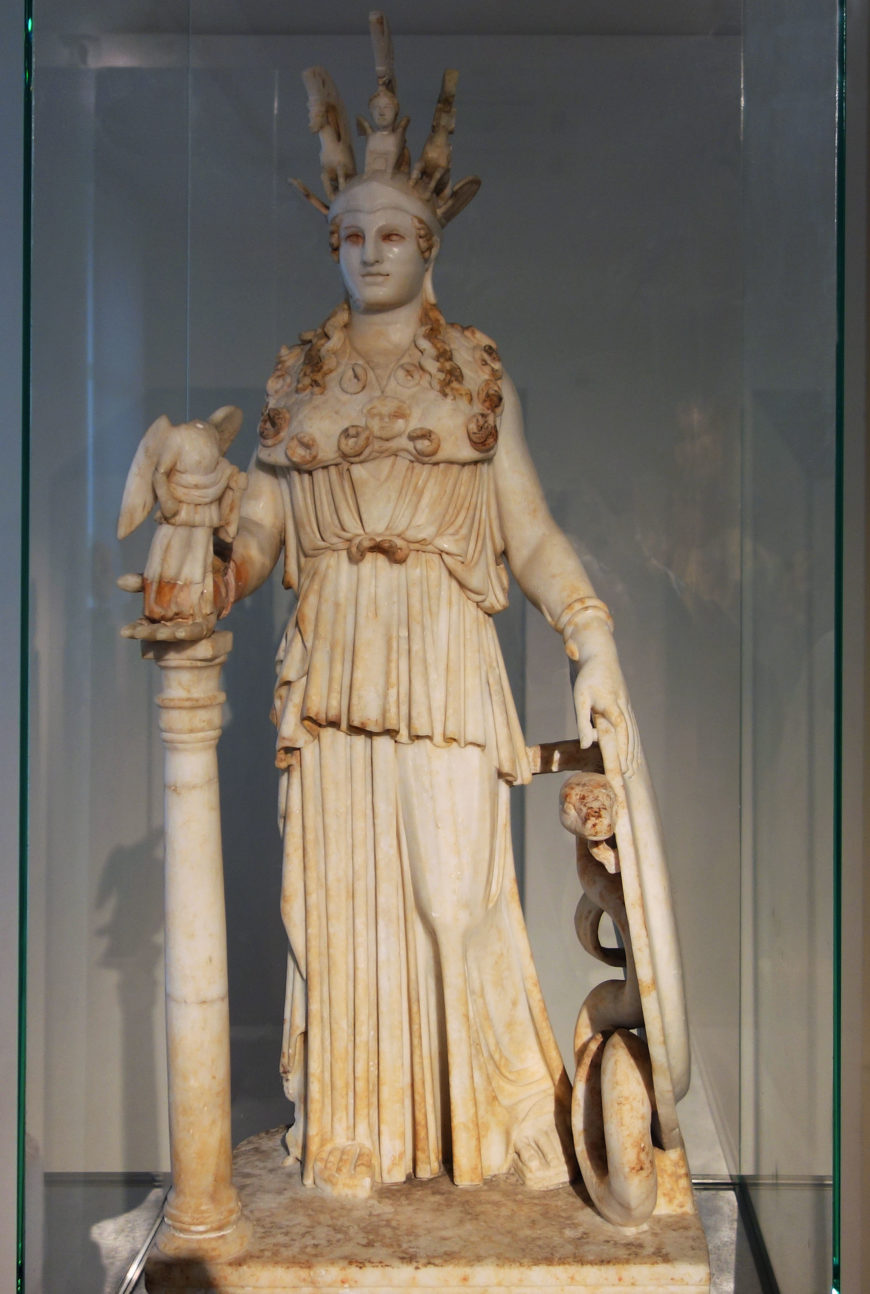
Pheidias, Athena Parthenos, 447–32 B.C.E. (this is a 3rd c. C.E. copy known as Varvakeion found in Athens), National Archaeological Museum in Athens; photo: Steven Zucker, CC BY-NC-SA 2.0)
The most sumptuous of these were generally funded by the citizens of Athens as a collective, such as two renowned colossi (no longer surviving): the bronze Athena Promachos (“in the frontline of battle”) and the chryselephantine Athena Parthenos (“the maiden”), both built by Pheidias (also spelled Phidias). Equipped with a shield and lance, the Athena Promachos towered over the Acropolis between the Parthenon and the Propylaea. In the Temple of Athena Nike (“the victorious”) was another cult statue of Athena, presumably seated and adorned with her battle gear. In the Erechtheion, the main temple of Athens, stood the relatively diminutive Athena Polias (“of the city”), and which differed from the previously mentioned votive statues because it was believed to have fallen from the sky and so was not made by human hands. [1] Such statues made tangible the different aspects of Athena (noted by the different names given to her) and typically became de facto cult images as worshippers prayed to them.
Scholars propose a busy “souvenir” industry at Greek sanctuaries, meaning visitors purchased, along the way to and perhaps even at the sanctuaries, offerings for the gods. Votive gifts, therefore, made a robust industry and also provide scholars with invaluable information on the religious life and visual culture of the Greeks. Painted pottery found on the Akropolis indicate that one of the most popular decorative subjects was, perhaps not unexpectedly, Athena herself, especially representations of her most famous sculptural forms.
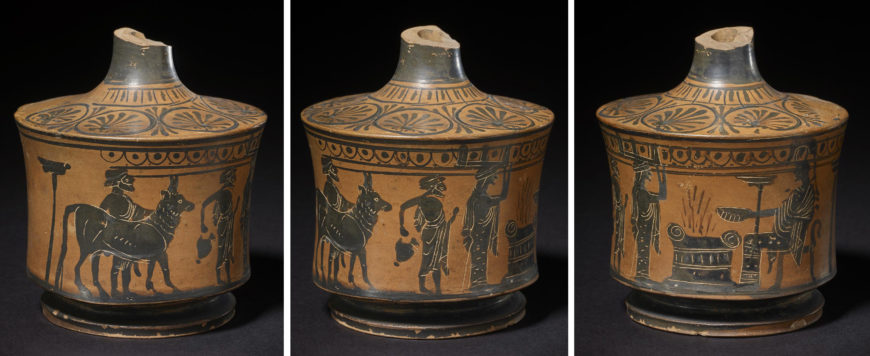
A black-figure lekythos shows a sacrifice to Athena (a bull led to sacrifice at an altar, and Athena enthroned holding a libation bowl). Attributed to the Gela Painter, c. 500-490 B.C.E. (The British Museum, © The Trustees of the British Museum)
A well-preserved black-figure lekythos shows a sacrificial procession, before an Athena seated in a simplified architectural setting that stands for both the Akropolis in its entirety and the sacred structures housing cult images. Other lekythoi show Athena Promachos being tended by a priest in a temple, while a sacrificial procession approaches her flaming altar.
The Athenas, while not entirely faithful to their respective cult-image prototypes, show that vase painters likely took as inspiration the sculptures and sacred structures they saw all around the sanctuary and Athens as a whole. We may suppose that a visitor dedicated an image of Athena Promachos to the Athena Promachos with the depiction of a perpetual sacrifice recalling the actual sacrifices the statue/goddess received regularly. Much like the myriad iterations the Statue of Liberty has received in other media following her erection, statues of Athena were reproduced constantly on vases and plaques that often accompanied these statues on the Akropolis.
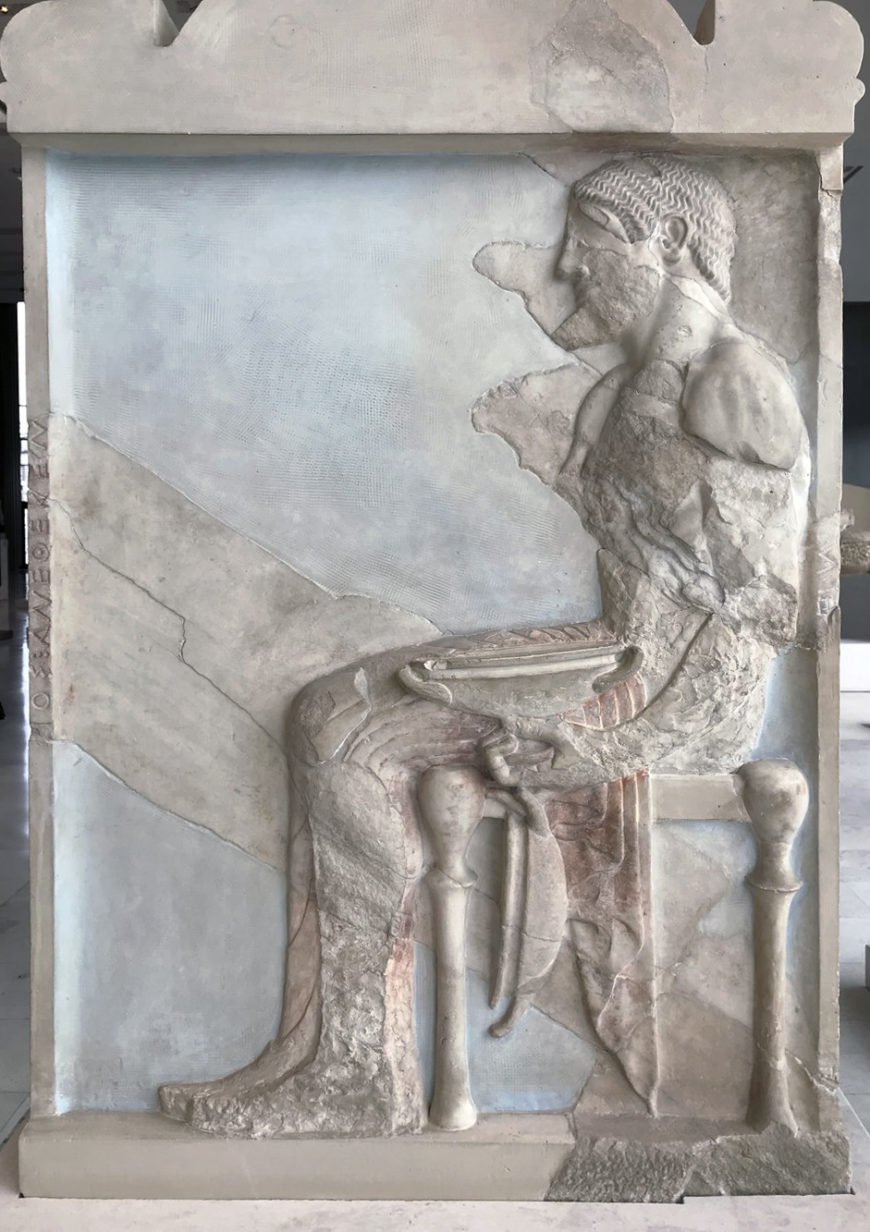
Endoios, Potter Relief, 520–510 B.C.E., marble from Penteli (The Acropolis Museum, Athens). The potter-dedicant sits on a stool (diphros) holding two kylikes (wine cups) he made himself.
A different kind of votive gift is the so-called “Potter Relief,” carved by Endoios and dedicated on the Akropolis by a potter whose inscribed name is now incomplete, is yet another sophisticated result of artistic collaboration. The potter, thankful for the good luck Athena Ergane (“the worker”) has bestowed, commissioned the sculptor to carve in stone the potter himself holding two of the kylikes he has produced.
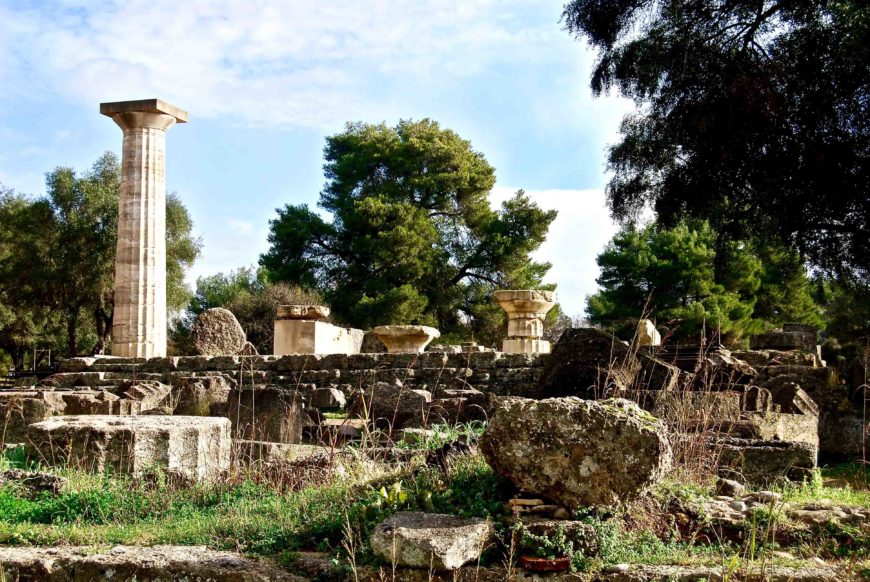
Temple of Zeus, c. 470–457 B.C.E., Olympia. A chryselephantine statue of Zeus by Pheidias that once stood inside, was one of the seven wonders of the ancient world (photo: Andy Montgomery, CC BY-SA 2.0)
An artistic battlefront: “War of Monuments” at Olympia
Arguably the most important Panhellenic sanctuary was that of Zeus at Olympia in Peloponnesos. Besides being the location of the Olympic Games, this sanctuary was where Greeks from all geographies, including the great colonies like Gela and Syracuse in Sicily, gathered to honor not only Zeus but almost all other primary deities and many ancestral heroes.
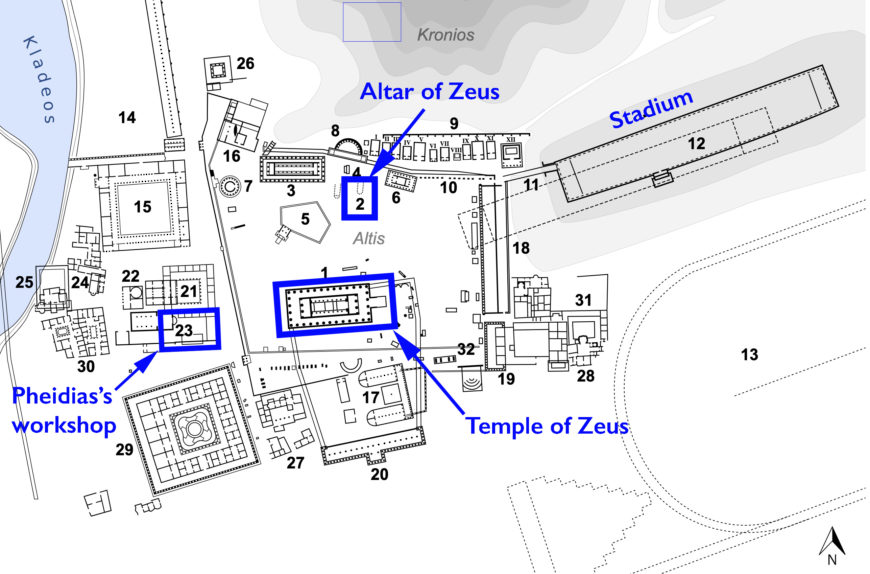
Site plan of the Olympia sanctuary, Greece. The artist Pheidias even had a workshop within the sanctuary.
Consequently, potential visibility by a large population of divine and mortal alike made every inch of Olympia precious real estate for dedications. The Classical Temple of Zeus, itself a votive offering funded by the city-state of Elis and dedicated to the patron god, along with its immediate surroundings quickly became the most prestigious spot for other votives. Around 456 B.C.E., following their victory at Tanagra over Athens, Sparta placed a golden shield on the temple roof. We do not know the exact details of the shield, but it was certainly seen by each and every visitor of Olympia as a gleaming reminder of Sparta’s success and the property Athens and her allies lost at Tanagra.
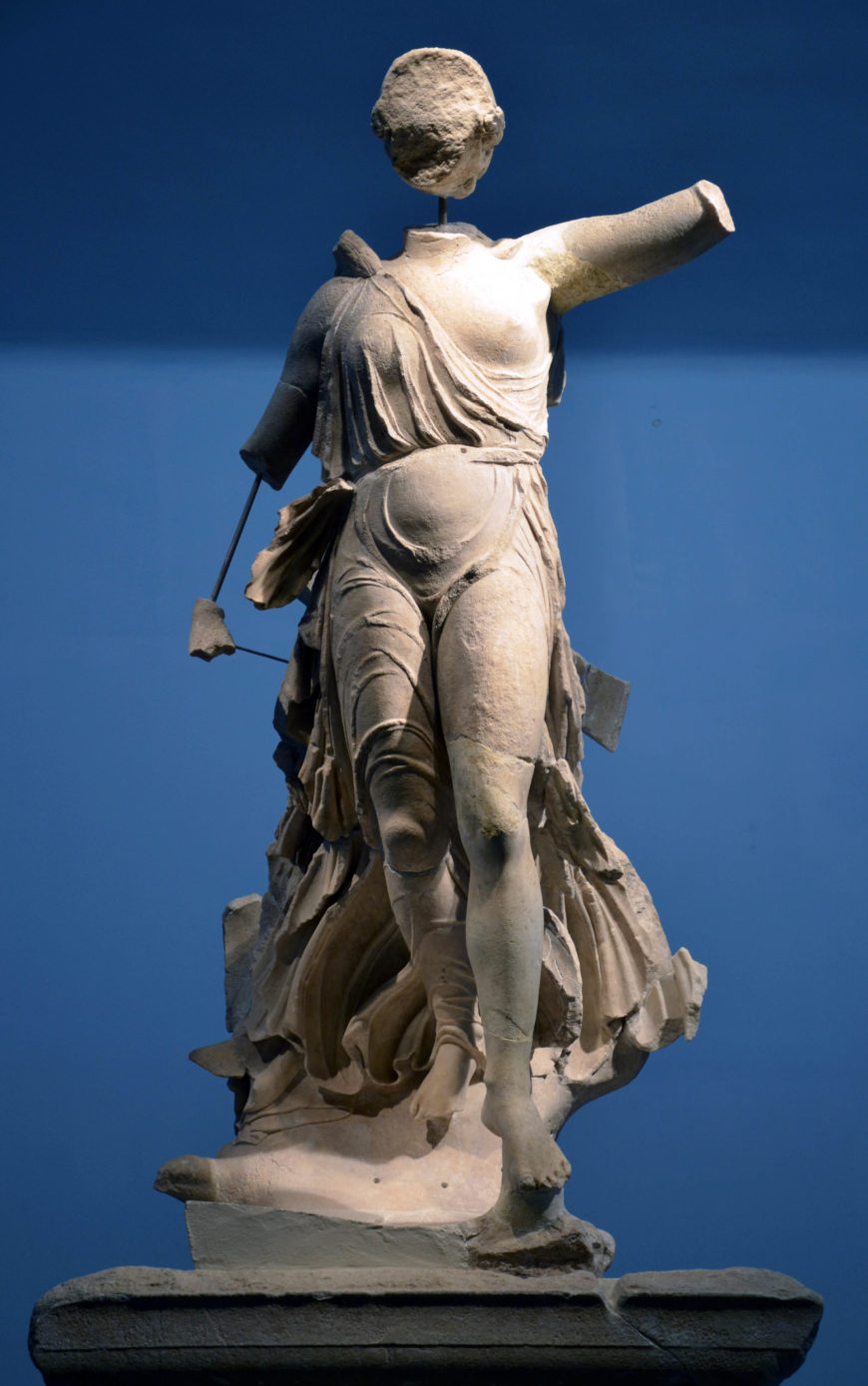
Nike of Paionios, c. 420 B.C.E., marble (Archaeological Museum of Olympia; photo: Carole Raddato, CC BY-SA 2.0)
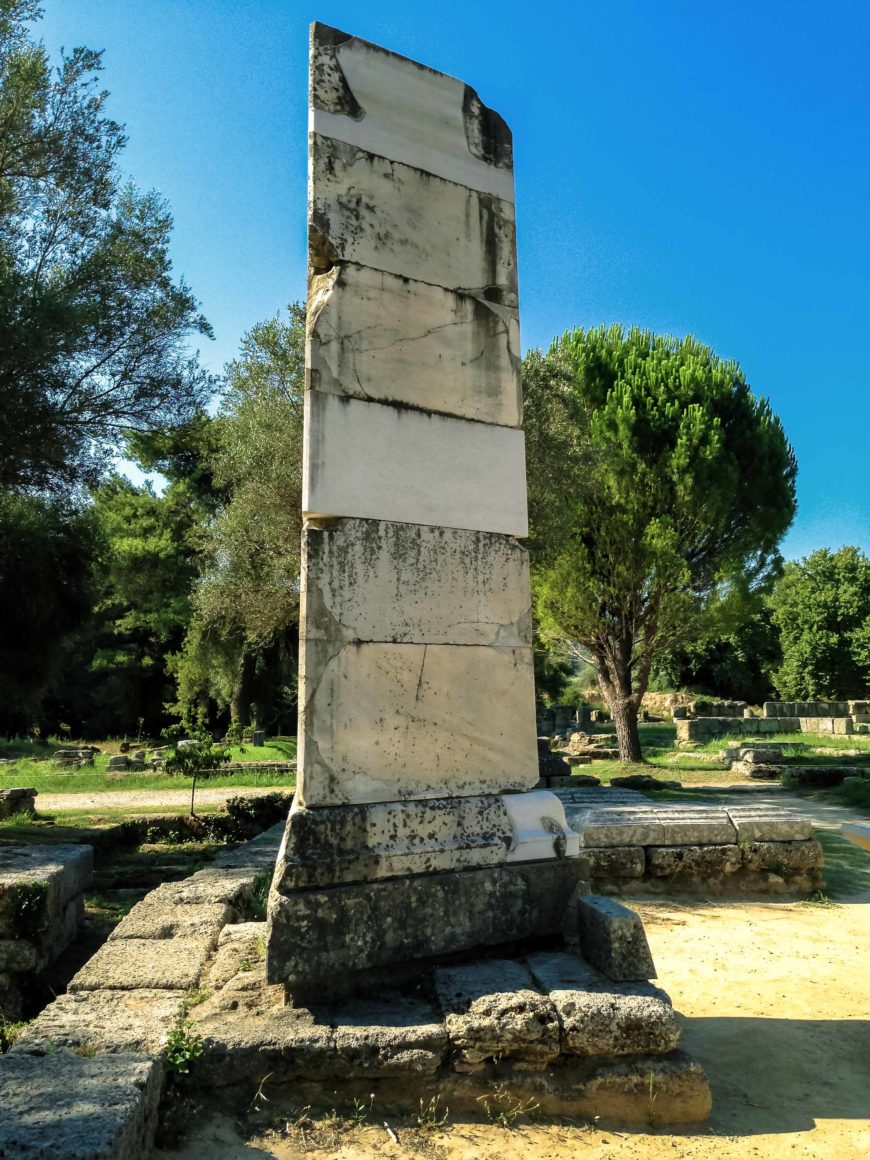
Plinth on which stood the Nike of Paionios across from the Temple of Zeus at Olympia (photo: Andy Hay, CC BY 2.0)
Decades later, however, Sparta got a direct response: In 425 B.C.E., with the help of Messenians and Naupaktians, Athens achieved a significant victory over Sparta on the island of Sphakteria. Some of the war booty was used to erect a winged Nike on a triangular pedestal across from the temple’s entrance. The sculpture, carved by Paionios of Mende (hence the name of this sculpture—Nike of Paionios) together with its base stood nearly 39-feet-tall. It depicted Nike about to touch land, presumably with a victory wreath in her hand. Holes on the pedestal indicate that shields decorated each side, and the inscription succinctly explains the reason for the dedication: “The Messenians and Naupaktians dedicated this statue to Zeus Olympios from the spoils of the wars. Paionios of Mende made it, who also won the competition to make the akroteria of the temple.” [2]
As the personification of victory, the Nike of Paionios is also meant to remind the viewer of the desirability and allure of being a victor, without shying away from any erotic connotation. The left breast of the figure is bare, yet it is her luxurious garment clinging to her curves that ends up exposing more—an excellent example of the “wet style” in Classical Greek sculpture. [3]
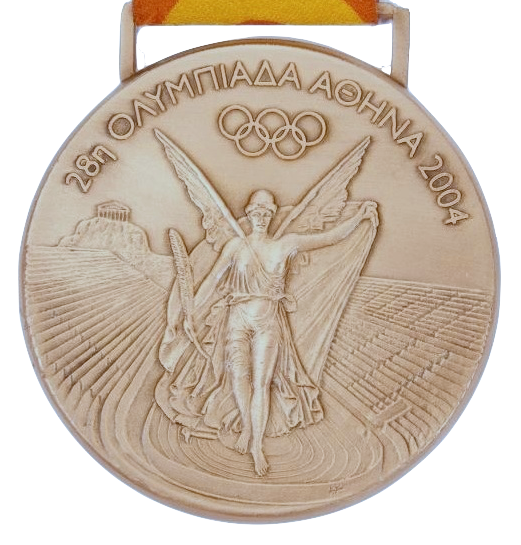
The Nike of Paionios on the front of the Olympic medal for the 2004 Olympic Games held in Athens, Greece
In more ways than one, the Nike of Paionios was the perfect votive offering in a sanctuary that thrived on the Greeks’ agonistic spirit in all its incarnations: war, politics, sports, beauty, and the favor of gods. No wonder, then, the medals for the 2004 Olympics bore as their primary image this very Nike soaring before the Akropolis and the renovated Panathenaic Stadium of Athens (Kallimarmaro).
Images into Words: Pausanias at Delphi
Scholars of Ancient Greek art do not always have the luxury to study artworks firsthand. The colossi of Athena Parthenos and the Spartan golden shield mentioned above are just two examples that have not reached our time but live on in replicas and, more often, the written word. Cult statues by the famous sculptors Pheidias, Alkamenes, Myron, and Euphranor, for instance, are used as a zany plot device in one of Lucian’s satirical plays.

An 1892 reconstruction of Polygnotos’s Nekyia (“underworld”) at Delphi reported by Pausanias, in Robert Carl, Hallisches Winckelmannsprogramm (Band 16): Die Nekyia des Polygnot (Halle a. S., 1892)
Perhaps the most valuable source, however, is a multi-volume travelogue written by Pausanias, a Greek living under Roman rule in the second century C.E. Visiting every accessible corner of mainland Greece, Pausanias noted the intricate etiologies (foundation myths), sacred rites, monuments, and conditions of cities, sanctuaries, and communities. The last book of his Description of Greece includes a lengthy section on the shrine of Apollo at Delphi (where some came to ask questions of the oracle). Two works of art that he describes extensively are two wall paintings decorating the interior of the lesche (clubhouse) of Knidians, both by the famous Classical painter Polygnotos.
Pausanias’ complete description of these paintings is too long to quote here, but it should be noted how they exemplify the fundamentality of interactions between different artistic media (inter-media) in ancient Greece. Both paintings used Archaic literary epics as their source: one depicted the fall of Troy in the aftermath of Homer’s Iliad and the other Odysseus’ journey to the underworld (nekyia) as related in the Odyssey. Polygnotos must have known these stories by heart, as they had always been cornerstones of folk song and popular literature. In each painting he depicted approximately seventy figures in what must have been overall compositions divided into several intertwining registers. So, the eighth-century B.C.E. epics were translated into monumental paintings by Polygnotos in the mid-fifth century B.C.E., and nearly half a millennium later, they were put back into words by Pausanias. This is how they were preserved until our “modern” times when scholars of Ancient Greece began parsing the Description of Greece to access so much that has been lost and recreated, albeit with a certain naivete, what Pausanias might have seen.[4]
Sanctuaries nurtured the psyche of Greeks in myriad ways, including giving them outlets to create and, consequently, opportunities to observe, appreciate, and (re)interpret all that had been created. Religion in Greece was ingrained in every aspect of life, so it makes perfect sense that sacred sites themselves were enriched by all means with which Greeks recorded their lives.
Notes:
[1] For a thorough history of the Athenian Akropolis and the cult of Athena in association with the Panathenaic Games, see Jenifer Neils, ed., Worshipping Athena: Panathenaia and Parthenon (Madison: University of Wisconsin Press, 1996).
[2] Translation from the “Nike of Paionios” page of Cambridge University’s Museum of Classical Archaeology Databases.
[3] Richard Neer, The Emergence of the Classical Style in Greek Sculpture (Chicago: University of Chicago Press, 2010, pp. 138-41.
[4] Mark D. Stansbury-O’Donnell, “Polygnotos’s Nekyia: A Reconstruction and Analysis,” American Journal of Archaeology vol. 94, no. 2 (1990), pp. 213–35
Additional resources
Read more about ancient Greek architecture
Learn more about the Siphnian Treasury at Delphi

